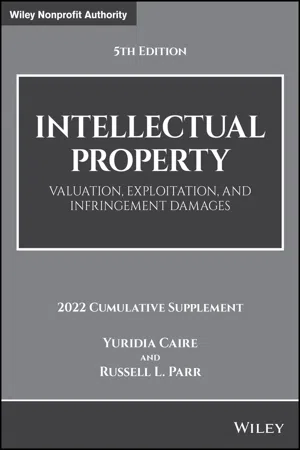
Intellectual Property
Valuation, Exploitation, and Infringement Damages, 2022 Cumulative Supplement
- English
- ePUB (mobile friendly)
- Available on iOS & Android
Intellectual Property
Valuation, Exploitation, and Infringement Damages, 2022 Cumulative Supplement
About this book
Stay informed about every major and recent development in the law of intellectual property in the US In the 2022 Cumulative Supplement to the 5th edition of Intellectual Property: Valuation, Exploitation, and Infringement Damages, a renowned team of authors delivers a comprehensive and authoritative review of the most relevant and impactful changes to the legal regime governing intellectual property in the United States. Current to the year 2022, the Supplement explores the legislative and regulatory changes, as well as major developments in case law, affecting intellectual property in the US. An indispensable update for lawyers advising founders, entrepreneurs, and executives in any industry, and business leaders themselves, this volume is a one-stop resource covering every applicable recent change in a rapidly evolving area of the law.
Frequently asked questions
- Essential is ideal for learners and professionals who enjoy exploring a wide range of subjects. Access the Essential Library with 800,000+ trusted titles and best-sellers across business, personal growth, and the humanities. Includes unlimited reading time and Standard Read Aloud voice.
- Complete: Perfect for advanced learners and researchers needing full, unrestricted access. Unlock 1.4M+ books across hundreds of subjects, including academic and specialized titles. The Complete Plan also includes advanced features like Premium Read Aloud and Research Assistant.
Please note we cannot support devices running on iOS 13 and Android 7 or earlier. Learn more about using the app.
Information
CHAPTER 29A
EVOLVING PATENT DAMAGES
Table of contents
- COVER
- TABLE OF CONTENTS
- TITLE PAGE
- COPYRIGHT
- ABOUT THE AUTHORS
- CHAPTER 13A: EXPLOITATION STRATEGIES
- CHAPTER 28A: ROYALTY RATES AND THE GEORGIA‐PACIFIC FACTORS
- CHAPTER 29A: EVOLVING PATENT DAMAGES
- CHAPTER 30A: TRADEMARK, COPYRIGHT, AND TRADE SECRET DAMAGES
- INDEX
- END USER LICENSE AGREEMENT